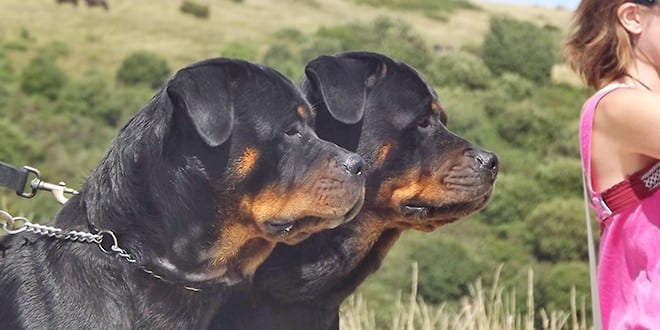Her Dog Shows Two Different Types Of Aggression
Dear Adam:
I am writing about our dog Rudy, a three year old goldie mix that we adopted five months ago from a shelter. We have received different opinions on his mix. Some have said goldie/shepherd, some have said goldie/chow. The latter is the opinion of the [local dog training academy], where he is presently enrolled in their one-month board and train program. We enrolled him because one month ago he attacked a jogger. The jogger was running by my husband, who had Rudy in a sit on a slack leash. The jogger changed direction quickly, running straight toward Derek and Rudy. Rudy lunged at the jogger, jumped up on him, barking and growling aggressively.
He tore the man’s jacket by nipping at it, but he did not bite the jogger.
[You weren’t paying attention to your dog. If you were, you’d have already been running the other direction to execute the “attention getter” drill as outlined in the book. -Editor]
The only other time he had displayed such aggressive behavior was toward a UPS driver coming up the driveway, but he was well under control that time.
He has a very strong prey drive and dominant personality. He had been doing very well these past three weeks at the Academy. They were not able to elicit any aggressive behavior from him, and his obedience training was going well. But last Thursday, he bit a trainer. He apparently was being put back into his kennel and ran off down a long hallway. He was not leashed. When he got to the dead end, he first went submissive, rolling over on his back. The trainer then reached to grab his collar and Rudy gave her hand a good bite. She then reached for the collar with her other hand, and he did the same to that hand. He did not give her any warning growl or snap. He did not move forward toward her, just reacted to her reach toward him. After the second bite she backed off, and another trainer was able to coax Rudy to go back with her uneventfully.
I have read your book and believe that the trainer bite was an example of fear aggression? (I don’t know what to think about the jogger, though.) The Academy seems to be saying that they can’t train that reaction out of him; that we will just need to be vigilant and mindful of his triggers. That goes without saying, and I now believe that being cornered is one of his triggers. (Our vet had also mentioned that when they cornered him to get him on a table, that he had snapped out at them.) But your book and tapes led me to believe that you can train such behavior out of a dog. Or am I misunderstanding? Are you merely just getting the dog to react to you instead of following his instinctual reaction? Certainly that’s a good thing, but what if he’s with someone else when he’s triggered?
We need some perspective on this situation. I love him and want to give him every chance to learn correct behaviors. But on the other hand, we live in a dense children and jogger packed neighborhood. We can’t keep him if there is reasonable risk of this kind of thing happening again.
Mary Ellen
Dear Mary Ellen:
Thank you for the e-mail.
You’ve got a couple of things to consider:
1. The dog needs to be firmly corrected lunging. Going after the biker is a prey-based aggression. Correct him for this, as described in the book.
2. Going after the trainer and the veterinarian is the result of the dog being insecure and not trusting the handler. Usually in these types of cases, he will not bite if he is secure that you will not hurt him. Or if he knows that he will only be fairly corrected for behavior that he understands.
With aggressive behavior, we can never say 100% “All” or “Never” that your dog will or will not show a specific behavior.
Regardless, your dog needs to be corrected for such behavior, and then shown that if he is calm, he gets praise and nothing bad happens to him. This can sometimes be achieved by placing the dog in such positions while he is wearing a muzzle. He cannot bite you, and ultimately learns that everything ends up “A-Okay.”
It is a process of deconditioning. Not so for the prey-aggression, which can be fixed with a couple of well-timed and motivational corrections.
That’s all for now, folks!
Copied with permission from: http://plrplr.com/43798/her-dog-shows-two-different-types-of-aggression/


